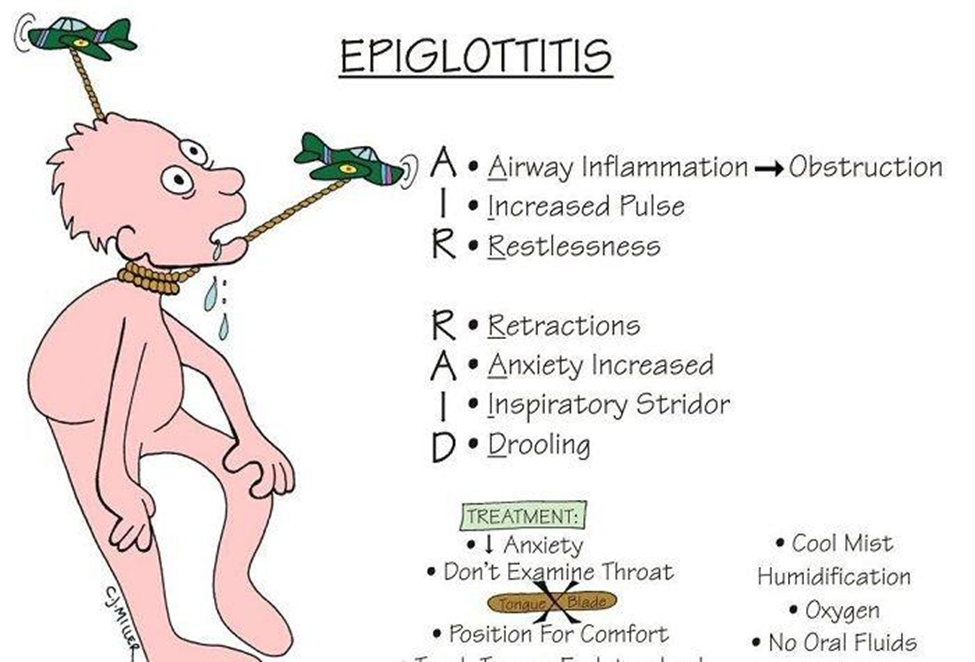The nurse in the emergency department is caring for a child who appears extremely ill with a high fever, unable to control their oral secretions. with voice hoarseness and inspiratory stridor and inspiratory sternal retractions while breathing. The nurse suspects epiglottitis. Which would the nurse do next?
Contact the assigned emergency room physician to evaluate the need for an advanced airway
Administer intravenous corticosteroids
Obtain a throat culture
inspect the throat to obtain further data to support the diagnosis
The Correct Answer is A
A. Contact the assigned emergency room physician to evaluate the need for an advanced airway
Explanation:
Epiglottitis is a medical emergency that can rapidly progress to airway obstruction. The classic signs and symptoms include a high fever, difficulty swallowing, voice hoarseness, inspiratory stridor, and sternal retractions. Immediate intervention may be necessary to secure the airway. Therefore, contacting the emergency room physician to evaluate the need for an advanced airway (such as intubation) is a priority.
B. Administer intravenous corticosteroids
Explanation: While corticosteroids may be used in the management of epiglottitis to reduce airway inflammation, securing the airway is the priority in the acute phase. Corticosteroids would typically be administered after securing the airway.
C. Obtain a throat culture
Explanation: Obtaining a throat culture is not the immediate priority in the case of suspected epiglottitis. Prompt intervention to secure the airway takes precedence over diagnostic tests.
D. Inspect the throat to obtain further data to support the diagnosis
Explanation: Direct visualization of the throat (inspection) may exacerbate the airway obstruction and is not recommended in the acute management of suspected epiglottitis. The priority is to secure the airway while minimizing agitation and discomfort for the child. Diagnostic procedures, such as obtaining a throat culture, can be considered after the airway is stabilized.

Nursing Test Bank
Naxlex Comprehensive Predictor Exams
Related Questions
Correct Answer is ["A","B","D"]
Explanation
A. Varicella (VARI): Correct
Explanation: The varicella vaccine protects against chickenpox. The CDC recommends that children receive the first dose of the varicella vaccine at age 1.
B. Diphtheria, tetanus, and acellular pertussis (DTaP): Correct
Explanation: The DTaP vaccine protects against diphtheria, tetanus, and pertussis. The first dose is typically given at 2 months, with subsequent doses given at 4 months, 6 months, 15-18 months, and 4-6 years of age.
C. Human papillomavirus (HPV4): Incorrect
Explanation: The HPV vaccine is not typically administered at age 1. It is usually recommended for adolescents, starting around age 11 or 12. The HPV vaccine is given in a series of doses.
D. Measles, mumps, rubella (MMR): Correct
Explanation: The MMR vaccine protects against measles, mumps, and rubella. The first dose is usually given at age 1, with a second dose recommended at 4-6 years of age.
E. Rotavirus (RV): Incorrect
The rotavirus vaccine is usually given in a series of doses starting at 2 months of age, with the last dose administered by 8 months. It is not a vaccine that is typically given at age 1.
Correct Answer is ["B","D"]
Explanation
A. Fever:
Incorrect: Fever is not a typical symptom of uncomplicated gastroesophageal reflux. If fever is present, it may indicate another underlying condition.
B. Vomiting:
Correct Answer: Vomiting is a common symptom of gastroesophageal reflux in infants. It may occur shortly after feeding.
C. Rigid abdomen:
Incorrect: A rigid abdomen is not a common finding in uncomplicated gastroesophageal reflux. It may suggest another issue that needs evaluation.
D. Wheezing:
Correct Answer: Wheezing or respiratory symptoms can be associated with GER, especially if stomach contents are aspirated into the airways.
E. Weight loss:
Incorrect: Unexplained weight loss is not a typical finding in uncomplicated GER. If weight loss is occurring, it may be due to other underlying issues that need investigation.
Whether you are a student looking to ace your exams or a practicing nurse seeking to enhance your expertise , our nursing education contents will empower you with the confidence and competence to make a difference in the lives of patients and become a respected leader in the healthcare field.
Visit Naxlex, invest in your future and unlock endless possibilities with our unparalleled nursing education contents today
Report Wrong Answer on the Current Question
Do you disagree with the answer? If yes, what is your expected answer? Explain.
Kindly be descriptive with the issue you are facing.
